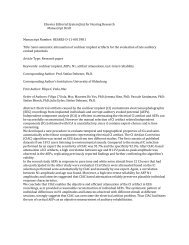An analytic Green's function for a lined circular duct containing ...
An analytic Green's function for a lined circular duct containing ...
An analytic Green's function for a lined circular duct containing ...
You also want an ePaper? Increase the reach of your titles
YUMPU automatically turns print PDFs into web optimized ePapers that Google loves.
SPL, dB<br />
50<br />
40<br />
30<br />
20<br />
10<br />
0<br />
−10<br />
−20<br />
−30<br />
−40<br />
−50<br />
0.8 0.85 0.9<br />
Radius (r)<br />
0.95 1<br />
ARTICLE IN PRESS<br />
S.W. Rienstra, B.J. Tester / Journal of Sound and Vibration 317 (2008) 994–1016 1011<br />
28+<br />
28−<br />
24+<br />
24−<br />
20+<br />
20−<br />
16+<br />
16−<br />
12+<br />
12−<br />
8+<br />
8−<br />
4+<br />
4−<br />
0+<br />
0−<br />
Total+<br />
Total−<br />
Free−field<br />
−50<br />
0.8 0.85 0.9<br />
Radius (r)<br />
0.95 1<br />
Fig. 12. Radial variation without flow of <strong>analytic</strong> and numerical Green’s <strong>function</strong> amplitudes per azimuthal mode, SPL ¼ 20 logðjGmjÞ,<br />
and total field SPL v. free-field Green’s <strong>function</strong> þ reflected SPL (o ¼ 31:354, M ¼ 0, Z1 ¼ 2:5, r0 ¼ 1, <strong>analytic</strong>: cut-off ratio ¼ 0:07,<br />
numerical: limited to 40 cut-off modes). <strong>An</strong>alytical (a), numerical (b). NB: The left and right running modal (<strong>analytic</strong> and numerical)<br />
Green’s <strong>function</strong>s, labelled Totalþ, Total , are indistinguishable in these no-flow results and oscillate about the Free-field Green’s<br />
<strong>function</strong>, which decays monotonically away from the source at r ¼ 1.<br />
The issue of a possible instability is still an open question. Causality considerations suggest, at least in the<br />
linear model, the presence of convective or even absolute instabilities. This has found support by numerical<br />
results in time domain [13]. Also experimentally there is evidence [14,15], at least <strong>for</strong> impedances of small<br />
resistance. In most cases, however, the exponentially large fields that would result have little resemblance with<br />
physical reality. There<strong>for</strong>e, we have not included any such instability in the presented numerical results and<br />
adopted stability of the solution as modelling assumption.<br />
Comparison of our <strong>analytic</strong>al mode amplitudes (<strong>for</strong> the hollow <strong>duct</strong> version of our solution) with the<br />
numerical solution of Alonso et al. showed a good agreement without mean flow, irrespective of how<br />
many modes are included in the matrix inversion <strong>for</strong> the numerical mode amplitudes. A large number of<br />
modes are required <strong>for</strong> convergence near the source. With flow, the mode amplitudes do not agree but<br />
as the number of modes included in the matrix inversion is increased, enough to include all important surface<br />
SPL, dB<br />
50<br />
40<br />
30<br />
20<br />
10<br />
0<br />
−10<br />
−20<br />
−30<br />
−40
















